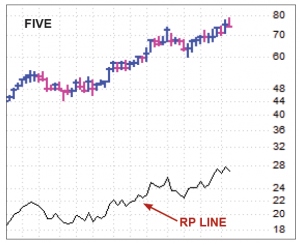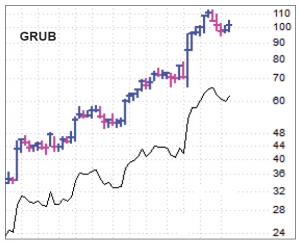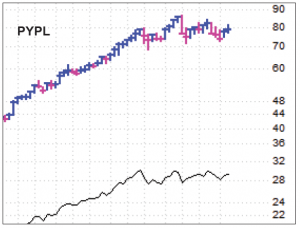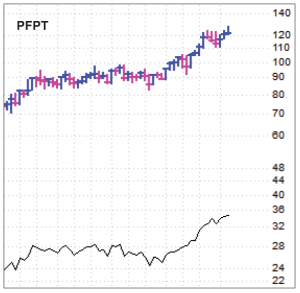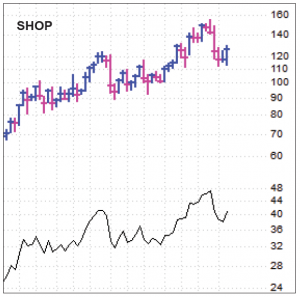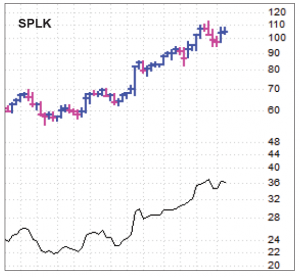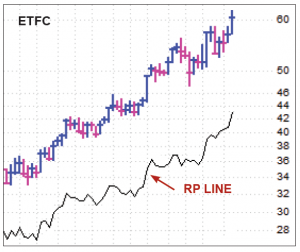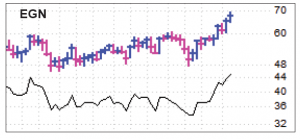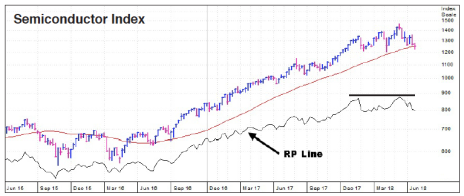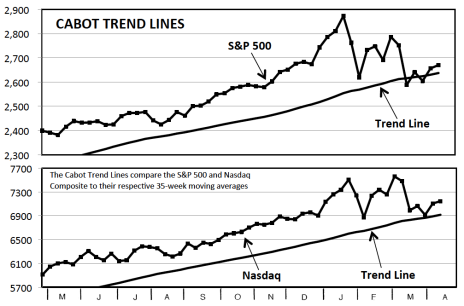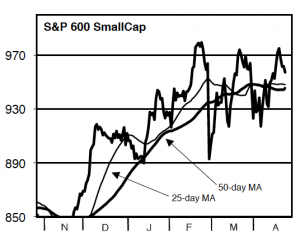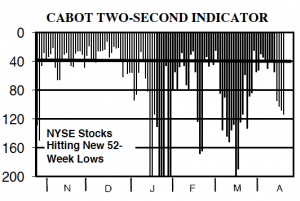The market had a great, bullish setup a couple of weeks ago, but that rally has fallen flat, which is a red flag. Our Cabot Tides and Two-Second Indicator remain negative, and we’re now seeing the selling spread even to resilient growth stocks.
Cabot Growth Investor 1392
[premium_html_toc post_id="149043"]
Swing and a Miss by the Bulls
Three weeks ago the market was showing a classic bullish setup. The major indexes had tested and held their February lows and their 200-day moving averages, numerous broad market measures flashed positive divergences (which are seen at many intermediate-term lows), a decent number of growth stocks were setting up in early-stage bases and investor sentiment had taken a hit.
To use a sports analogy, the bulls were getting a fastball down the middle of the plate. But they swung and missed! The rally that ensued came on low volume and never really kicked into gear. Few stocks really got going, and our Cabot Tides (intermediate-term trend) never turned positive. And now, during the past week, the rally has faltered, with the major indexes seeing distribution and many popular names (like Apple, Google and 3M) getting smashed.
To us, the fact that the market had a solid setup and couldn’t do anything with it is a red flag, as is the fact that the market continues to rifle through “reasons” for its weakness. Three months ago it was short-volatility products, then it was steel and aluminum tariffs, then a Chinese trade war and now it’s interest rates. Next week it could be oil prices or the economy. Who knows! The point is the buyers have failed to take control.
We’re not making some grand prediction of doom and gloom. In fact, with the longer-term trend pointing up, those previous positive divergences in the broad market and a bunch of (early stage) growth stocks building normal-looking launching pads (many of which are reporting earnings soon), it wouldn’t surprise us if this latest selling wave proves to be the final shakeout to this tedious correction. We’re not throwing the baby out with the bathwater, in other words.
But given the weak rally and the recent selling pressure in both the indexes and many liquid (institutionally-sponsored) stocks, the onus is clearly on the bulls at this point. If they don’t step up soon, it’s looking more likely that a third leg down to this correction will be underway. For now, we’re preaching caution and are focused on preserving capital until the next uptrend begins.
[highlight_box]WHAT TO DO NOW: Remain cautious. In the Model Portfolio, we added Nutanix (NTNX) last week, but on a Special Bulletin last night, we cut our loss in HubSpot (HUBS) and placed Splunk back on Hold. The portfolio’s cash position is now 45%.[/highlight_box]
Model Portfolio Update
The Model Portfolio has been in a relatively cautious stance ever since the market correction gained steam in early February, with our cash position ranging from the low-20% range to the mid-40% range during that time as conditions for growth stocks just haven’t been favorable.
Right now, we’re mostly focused on managing our current crop of stocks as earnings season accelerates; we have a couple of stocks reporting this week and more after that. As always, we’ll be aiming to hold our strongest stocks, while keeping any weakening positions on tight leashes.
Back to the overall portfolio, we added Nutanix last week, bringing our cash level down to 34%, though our sale of HubSpot on last night’s Special Bulletin boosted that back to 45%. If we are forced to kick another stock or two out of the portfolio, we could replace them, but we’re not aiming to increase the portfolio’s overall exposure until our market timing indicators flash green lights—and we could raise even more cash if the selling pressures continue to intensify.
Current Recommendations
BUY—Five Below (FIVE 73)—In choppy or down market environments, breakouts usually falter; buyers aren’t willing to bid up for stocks that are at new highs, and sellers are often quick to cut back on positions that perk up. So it’s not totally surprising that FIVE has turtled back into its base, retreating a few points after a nice rally since its lows in early February. (A pullback in retail stocks, due in part to rising interest rates and oil prices, hasn’t helped, either.) It’s always possible the decline turns ugly—a drop back into the lower 60s would be abnormal—but so far the damage is limited, with the stock around its rising 25-day line, which is positive given the market. Fundamentally, of course, nothing has changed, with years of 15% to 20% store count growth (and consistent same-store sales growth) driving sales and earnings higher over time. With the stock’s overall trend pointed up, we’ll stay on Buy, but we continue to advise keeping new positions on the small side (half or two-thirds of what you’d normally buy, dollar-wise) given the market. The stock was just added to the S&P 400 Midcap Index (and taken out of the S&P 600 SmallCap), but we don’t see that as a big event either way.
HOLD—Grubhub (GRUB 96)—GRUB looks a lot like the overall market during the past month, with a sharp pullback in the second half of March, an OK-not-great move up this month and now a fresh selloff as the buyers step aside. The stock has received some positive mentions recently (one top-notch money manager talked up the stock at this week’s Sohn conference, pointing to its huge market opportunity) as well as some cautious commentary (a Morgan Stanley analyst downgraded shares based on its big run in recent months and elevated valuation). Like most stocks, the big key will be earnings—Grubhub will report first-quarter results the morning of May 1, with analysts expecting revenues to rise 47% and earnings to lift 34%. But lots of attention will be paid on the sub-metrics (how active is the customer base) and any initial results from the Yelp integration and the deal with Yum! Brands. We’re still leaning toward the view that GRUB probably needs more time to consolidate and correct after more than doubling from mid-October through February, but we’re open to anything. If you’re in a similar position (big profit, have already sold some shares for great gains), we advise sitting tight and seeing what earnings brings.
SOLD—HubSpot (HUBS 105)—We made the quick (and unusual) switch of HubSpot from a Buy rating directly to a Sell on our Special Bulletin last night. Granted, the chart isn’t a horror show (about 12% off all-time closing highs), but the fact is that HUBS gave up all of its modest April bounce in just four days, and on increasing volume, too. Moreover, we had a loss (which we don’t like to play around with in bad markets) and we see some other, more resilient cloud software stocks out there—if and when the market correction ends, our guess is that some of HUBS’ peers will be better stocks to own. We sold last night and are holding the cash.
BUY—Nutanix (NTNX 51)—Our timing on the buy of NTNX last week couldn’t have been much worse—the market began to fall a couple of days later, which has yanked the stock down a couple of points. That said, compared to most names it’s still in great shape, hovering just below its 25-day line. As we’ve written before, we think NTNX is an emerging blue chip in the tech field, as it’s leading a new infrastructure sector (hyperconverged infrastructure) and landing tons of huge clients. And most of Wall Street thinks the company’s gigantic longer-term outlook—a four-fold increase in bookings by 2021, equating to 40% annual growth!—is very believable. Obviously, the stock could crack if the market remains under pressure, but because of the huge story and relative resilience, we’re determined to give it a chance. We have a mental stop in the mid 40s; if you have a ton of cash, you could nibble here.
HOLD—PayPal (PYPL 74)—PYPL has basically moved sideways since Thanksgiving, with little net progress and a flat relative performance (RP) line. Given its big prior run, this consolidation has been normal thus far, but we’re probably getting close to the make-or-break point. Sure enough, earnings are due out tonight, with analysts looking for 21% revenue growth and earnings of 54 cents per share. Our overall stance with the stock hasn’t changed much despite its ups and downs in recent weeks—a break of long-term support in the 71 to 72 area would tell us the major uptrend is cracking, but above there, we’re happy to give it a chance. Bigger picture, PYPL, like many stocks last year, broke out of a big (21-month) consolidation and had a great run for nine months until topping; given the relatively brief run (compared to its base), it would be unusual for the stock to form a major top unless business or the market really imploded. Thus, we’re optimistic, but as always we’ll just play it by the book. Hold for now, and see what earnings brings.
BUY—Proofpoint (PFPT 120)—Cybersecurity stocks continue to impress, with Proofpoint (and some peers like Palo Alto Networks and Fortinet) remaining perched near their highs despite the sloppy market. (We like the general look of PFPT’s RP line in the weekly chart here, with a steady advance in recent months coming after a long sideways period.) All of that is to the good, but like most stocks, earnings will probably tell the intermediate-term tale—results are due out tomorrow night (April 26), with consensus estimates calling for a 34% hike in revenue and earnings of 15 cents per share. Whether it’s sooner or later, we think PFPT and the cybersecurity group is likely to have a good run; with the stock still resilient, we’ll stay on Buy and are aiming to give it some rope, but will also be closely watching its post-earnings reaction.
HOLD—Shopify (SHOP 120)—Chart-wise, SHOP is probably our weakest stock, but we’re still hanging on because (a) we have a big profit and (b) our position is very small (just 3% of the portfolio) and (c) the stock is still handily above its intraday low from earlier this month. Plus, we’re more than just chart watchers. Fundamentally, we think business remains in great shape despite a stream of short-selling commentary claiming the company is about to hit a wall. A break of the longer-term 200-day line (113 or so) would have us throwing in the towel, but having stuck with a small piece of SHOP to this point, we’d like to give it a chance and see how shares react to earnings (due out May 1). Note: If you have a loss or a “regular” sized position (for us, that would be around 10% of the portfolio), you can consider paring back given the market. But if you have a small position and/or a profit, we advise sitting tight and giving SHOP a little room.
HOLD—Splunk (SPLK 98)—SPLK has turned sloppy with most growth stocks, which is a negative and (along with the overall market) is why we’re quickly moving back to a Hold rating. Overall, though, the stock hasn’t done anything seriously wrong, gyrating between 95 and 110 during the past month and a half. And, given that the company’s recent multi-year outlook was just released late last month (25%-ish revenue growth this year and next with much faster earnings and cash flow growth), we don’t think the fundamental story has changed. Long story short, we still think Splunk has solid potential if the market doesn’t fall apart, so we want to give it a shot. But we’re sticking with a stop in the low- to mid-90s (at or just above our cost basis) in case the sellers take control.
Watch List
Axon Enterprises (AAXN 43): AAXN has, impressively, quieted down in recent days after its move to new highs at the start of April. The firm continues to get a bunch of orders for its electrical weapons, in-car and body cameras and for its Evidence.com digital evidence management platform. Earnings are likely out in late May.
Continental Resources (CLR 65) or Energen (EGN 67): CLR and EGN remain two of our favorite ways to play the move in energy stocks—a move we think has legs after the sector consolidated for all of last year. We write more about EGN below.
E*Trade (ETFC 60): We got kicked out of ETFC during the market’s February plunge, but unlike our other sells, the stock has held up very well despite the iffy market. See below for more.
Floor & Décor (FND 53): FND remains in great shape following its breakout earlier this month. Higher interest rates could dent investor perception, but (a) there’s no sign of that yet and (b) this growth story is about a lot more than a strong housing market.
Etsy (ETSY 29): We think it’s likely ETSY needs more time to consolidate even if the market turns positive. But the big-picture growth story remains compelling, and its stock remains very resilient, so we’re keeping it on our watch list.
Okta (OKTA 42): OKTA is a cloud software firm that specializes in identity solutions, allowing it to play in both the security and productivity-enhancing sectors. Revenue growth is rapid, and the stock actually hit new highs this week before being yanked down by the market.
Spotify (SPOT 153): Spotify is a new issue, but it’s the #1 player in the online streaming music business, with rapid revenue growth and huge growth potential. A couple of weeks of base-building could offer an entry point. See page 6 for more.
Other Stocks of Interest
The stocks below may not be followed in Cabot Growth Investor on a regular basis. They’re intended to present you with ideas for additional investment beyond the Model Portfolio. For our current ratings on these stocks, see Updates on Other Stocks of Interest on the subscriber website or email mike@cabotwealth.com.
E*Trade Financial (ETFC 60) — While the broad market has been tumultuous, financial stocks have been an oasis of calm, as investors anticipate that higher interest rates will benefit companies in the sector. In the latest quarter, E*Trade’s total customer assets increased by 17% to $393 billion, with interest-earnings assets rising to nearly $60 billion. In addition, while the company’s revenue has increased by more than 20% in the four most-recent quarters, earnings growth rates have jumped from 8% in Q3 2017 to 52% in Q4 and 83% in Q1 2018 (boosted in part by the corporate tax cut). ETFC has been in an uptrend since it came out of a six-month flat base in June 2017; it’s had five meaningful pullbacks during that run, but the general trend is clearly up and the stock actually pushed out to new highs last week after earnings. If the markets calm down and investors push trading volume higher, ETFC will be a powerhouse.
Energen (EGN 67) — With operations restricted to the Permian Basin of West Texas and New Mexico, Energen is a very focused oil & gas explorer. The company has an identified inventory of more than 4,000 drilling locations on its nearly 150,000 net acres in the Midland and Delaware Basins, and its third-generation drilling and fracking techniques are keeping costs low and production growing. After a couple of years of declining revenue during the oil slump, Energen’s revenue grew by 80% in 2017, with triple-digit earnings growth in each of the last three quarters. Analysts are expecting a whopping 367% jump in earnings in 2018 (partially because of tax cuts) and 33% in 2019. Energen is a very disciplined company, and expects its program of drilling to tap only a small percentage of its identified locations every year. After a huge sideways period, the stock has turned strong and looks like a leader in the energy patch.
Shake Shack (SHAK 43) — Shake Shack’s rapidly expanding string of retro-themed hamburger restaurants create a lot of buzz when they open. The offerings (including healthy items and a menu for dogs) feature quality ingredients and a hip presentation that’s produced a cult-like following. The store count stood at 159 at the end of 2017, which included 45 stores opened during the prior 12 months (a 40% increase). And the company expects to double its 2017 store count by the end of 2020! All those openings boosted revenue by 34% during 2017, though same-store sales growth was modest (0.8%) in the fourth quarter. Some analysts are impatient with revenue growth driven solely by new locations, but SHAK, which soared out of a 21-month base last September, is building a new, constructive launching pad as investors wait for the company’s latest results on May 3 after the close.
Twilio (TWLO 41) — Twilio’s claim to fame is its cloud-based platform that lets companies (or their software developers) build voice, text, chat and video capabilities into everything they do. The company’s APIs (application protocol interfaces) speed communication without having a separate infrastructure to build or maintain. Revenue growth has been great (44% in 2017) and the company is inching toward profitability, which is expected to come in 2019. The big knock on Twilio has been that an overreliance on a relatively few customers (like Uber and WhatsApp) makes it vulnerable to any cancellation by a major client, but those fears are being alleviated as the customer base broadens and growth remains robust. TWLO went into a post-IPO slump October 2016, falling from its September high of 71 to 24 in May 2017. But after a long base-building process TWLO caught an updraft in February after a well-received earnings report. With TWLO back above 40, the upcoming quarterly report on May 8 will be crucial. Watch closely.
Out With the Old, In With the New?
Spotify (SPOT)
With the market still futzing around in a corrective phase, we’re spending most of our time monitoring individual stocks and sectors, looking for those that are taking pole position for the next leg up. It’s easiest to spot strength in a choppy-to-weak environment.
What’s interesting is that, despite a couple of solid rallies since the market top in January, we’re still seeing suspect action from many of the obvious, later-stage groups that have enjoyed huge run-ups. Chip stocks are one example—the group advanced a whopping 106% from its breakout after Brexit (July 2016) to its peak a few weeks ago. But notice how the relative performance (RP) line hasn’t made any progress in months and the index is now testing its long-term 40-week moving average.
We’re not silly enough to call a top in the chip stocks, or any other late-stage group for that matter. But what’s obvious rarely works in the stock market—once a stock or sector becomes overly popular, much of the growth will be discounted and the buyers and sellers will fight it out.
That’s why, for new buying, we’re mostly focused on fresher areas, including retail, cybersecurity, select technology infrastructure and even energy. We’re also keeping an eye on the IPO pipeline. What’s interesting is that, despite the market doldrums, a handful of companies with great growth stories have come public in recent weeks, and their stocks are already garnering some institutional attention.
Spotify (SPOT), which is the largest global music streaming company (more than 35 million tracks!), is one we’re very intrigued by, as the stock is high-priced and already very liquid (it’s traded at least a million shares every day since its IPO), a sign that big investors are active. The potential here is obvious: Spotify could be the next big Internet success story, with its music streaming service used by around 157 million people near year-end and still growing rapidly.
About 86 million of those users have signed up for the company’s free streaming service, which allows shuffle play but has limited skipping ability and includes advertisements (sort of similar to Pandora). In itself, this is a big opportunity—Spotify believes the ad-supported free offering can be a success on its own, and indeed, revenues from this platform rose 51% in 2016 and 41% to 2017, even as free subscribers rose “only” 17% during the past year.
Even so, it’s the company’s Premium offering that is driving growth, accounting for 90% of total revenue each of the past couple of years. Paying subscribers ($10 per month) get not just access to the company’s entire music library, but see no ads, can skip songs at will, build their own playlists and even download songs for offline listening. At year-end, Spotify had a huge 71 million paying subscribers, and revenue from this premium segment lifted 38% last year.
As for the future, what’s exciting is that the company is both a leader in its field (management believes it’s nearly twice the size of its nearest competitor, Apple Music), and still has big growth potential given its presence in 65 countries. (Spotify is Swedish, and its largest market is Europe, but it’s making inroads everywhere; North America makes up about one-third of its user base.) Indeed, one analyst thinks the firm’s subscriber base (both free and premium) can grow to 300 million within three years! Looking back, revenues have grown 37%, 45%, 45% and 50% during the past four quarters, so if anything, business is picking up steam.
Obviously, competition will probably be a constant news item for investors, with every Apple (or other major player) acquisition or move potentially affecting SPOT in the short-term. But our thought is that the leaders in fast-growing industries like this (think Netflix) tend to remain leaders, and this mass market is big enough for a few players.
There’s not much to analyze yet with the chart, as SPOT just began trading earlier this month. But, as noted above, we’re impressed with the volume and the stock’s calmness—it swings around on a day-to-day basis, but so far shares have basically ranged from 140 to 160, which isn’t crazy given its newness and the market’s action.
Of course, buying new issues like this can be very tricky and lead to quick losses if something goes awry. But history has taught us that many high-quality, institutionally-favored IPOs can go on to have big runs. Bottom line: We think SPOT has great potential, and if the market can shape up and this stock can tighten up, we could take a swing at it. WATCH.
Cabot Market Timing Indicators
There have been many encouraging signs during the past few weeks, but the rubber-meets-the-road indicators (the intermediate-term trend of the market and the action of leading growth stocks) never kicked into gear, and now we’re seeing the sellers flex their muscles again. Translation: It’s best to stay cautious.
Cabot Trend Lines: Bullish
The market’s correction has been going on for three months, but our Cabot Trend Lines continue to tell us that the longer-term trend is up. Last week, both the S&P 500 (by 1.2%) and Nasdaq (by 3.3%) closed above their respective 35-week moving averages, telling us that the odds continue to favor higher prices when looking months down the road.
Cabot Tides: Bearish
Our Cabot Tides are still stuck in negative territory because, while most indexes got above their lower (25-day) moving averages, those moving averages never turned up, which is needed for a buy signal—and now the sellers are doing damage again. Granted, some indexes look better than others; the S&P 600 SmallCap (shown here), for instance, is still in decent shape. All told, though the intermediate-term trend is still pointed down, which is a good reason to stay close to shore.
Two-Second Indicator: Unhealthy
The broad market did show some improvement a couple of weeks ago, including the positive divergence spotted by the Two-Second Indicator when the indexes retested their February. However, the number of new lows is still north of 40 on most days, including a few triple-digit readings this week—a sign the sellers are still active.
[premium_html_footer]
Send questions or comments to mike@cabotwealth.com.
Cabot Growth Investor • 176 North Street, Post Office Box 2049, Salem, MA 01970 • www.cabotwealth.com
All Cabot Growth Investor’s buy and sell recommendations are made in issues or updates and posted on the Cabot subscribers’ website. Sell recommendations may also be sent to subscribers as special bulletins via email and the recorded telephone hotline. To calculate the performance of the portfolio, Cabot “buys” and “sells” at the midpoint of the high and low prices of the stock on the day following the recommendation. Cabot’s policy is to sell any stock that shows a loss of 20% in a bull market (15% in a bear market) from our original buy price, calculated using the current closing (not intra-day) price. Subscribers should apply loss limits based on their own personal purchase prices.
Charts show both the stock’s recent trading history and its relative performance (RP) line, which shows you how the stock is performing relative to the S&P 500, a broad-based index. In the ideal case, the stock and its RP line advance in unison. Both tools are key in determining whether to hold or sell.
THE NEXT CABOT GROWTH INVESTOR WILL BE PUBLISHED MAY 9, 2018
We appreciate your feedback on this issue. Follow the link below to complete our subscriber satisfaction survey: Go to: www.surveymonkey.com/marketlettersurvey
Neither Cabot Wealth Network nor our employees are compensated by the companies we recommend. Sources of information are believed to be reliable, but are in no way guaranteed to be complete or without error. Recommendations, opinions or suggestions are given with the understanding that subscribers acting on the information assume all risks. © Cabot Wealth Network. Copying and/or electronic transmission of this report is a violation of U.S. copyright law. For the protection of our subscribers, if copyright laws are violated, the subscription will be terminated. To subscribe or for information on our privacy policy, call 978-745-5532, visit www.cabotwealth.com or write to support@cabotwealth.com.
[/premium_html_footer]



